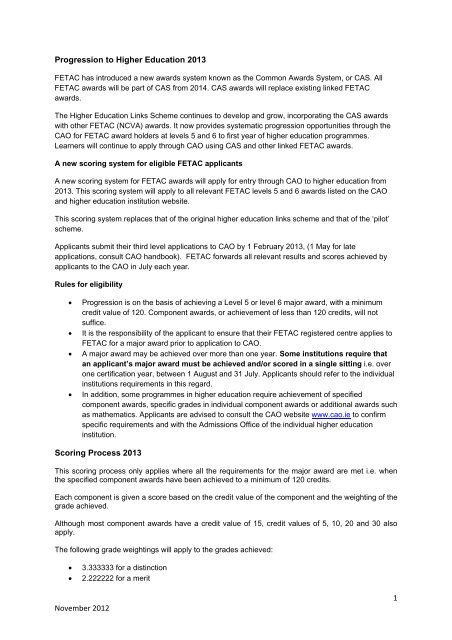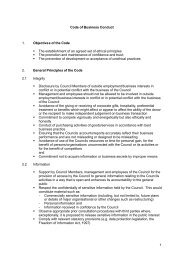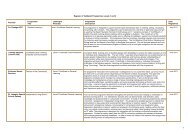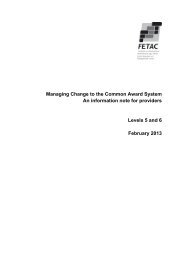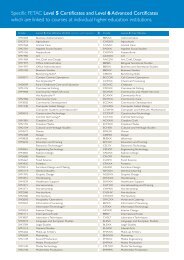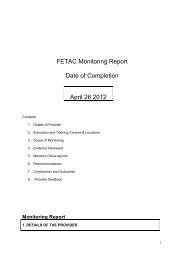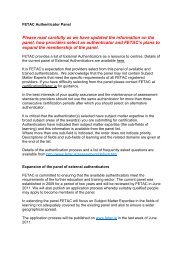1 November 2012 Progression to Higher Education 2013 ... - Fetac
1 November 2012 Progression to Higher Education 2013 ... - Fetac
1 November 2012 Progression to Higher Education 2013 ... - Fetac
You also want an ePaper? Increase the reach of your titles
YUMPU automatically turns print PDFs into web optimized ePapers that Google loves.
<strong>Progression</strong> <strong>to</strong> <strong>Higher</strong> <strong>Education</strong> <strong>2013</strong><br />
FETAC has introduced a new awards system known as the Common Awards System, or CAS. All<br />
FETAC awards will be part of CAS from 2014. CAS awards will replace existing linked FETAC<br />
awards.<br />
The <strong>Higher</strong> <strong>Education</strong> Links Scheme continues <strong>to</strong> develop and grow, incorporating the CAS awards<br />
with other FETAC (NCVA) awards. It now provides systematic progression opportunities through the<br />
CAO for FETAC award holders at levels 5 and 6 <strong>to</strong> first year of higher education programmes.<br />
Learners will continue <strong>to</strong> apply through CAO using CAS and other linked FETAC awards.<br />
A new scoring system for eligible FETAC applicants<br />
A new scoring system for FETAC awards will apply for entry through CAO <strong>to</strong> higher education from<br />
<strong>2013</strong>. This scoring system will apply <strong>to</strong> all relevant FETAC levels 5 and 6 awards listed on the CAO<br />
and higher education institution website.<br />
This scoring system replaces that of the original higher education links scheme and that of the ‘pilot’<br />
scheme.<br />
Applicants submit their third level applications <strong>to</strong> CAO by 1 February <strong>2013</strong>, (1 May for late<br />
applications, consult CAO handbook). FETAC forwards all relevant results and scores achieved by<br />
applicants <strong>to</strong> the CAO in July each year.<br />
Rules for eligibility<br />
<strong>Progression</strong> is on the basis of achieving a Level 5 or level 6 major award, with a minimum<br />
credit value of 120. Component awards, or achievement of less than 120 credits, will not<br />
suffice.<br />
It is the responsibility of the applicant <strong>to</strong> ensure that their FETAC registered centre applies <strong>to</strong><br />
FETAC for a major award prior <strong>to</strong> application <strong>to</strong> CAO.<br />
A major award may be achieved over more than one year. Some institutions require that<br />
an applicant’s major award must be achieved and/or scored in a single sitting i.e. over<br />
one certification year, between 1 August and 31 July. Applicants should refer <strong>to</strong> the individual<br />
institutions requirements in this regard.<br />
In addition, some programmes in higher education require achievement of specified<br />
component awards, specific grades in individual component awards or additional awards such<br />
as mathematics. Applicants are advised <strong>to</strong> consult the CAO website www.cao.ie <strong>to</strong> confirm<br />
specific requirements and with the Admissions Office of the individual higher education<br />
institution.<br />
Scoring Process <strong>2013</strong><br />
This scoring process only applies where all the requirements for the major award are met i.e. when<br />
the specified component awards have been achieved <strong>to</strong> a minimum of 120 credits.<br />
Each component is given a score based on the credit value of the component and the weighting of the<br />
grade achieved.<br />
Although most component awards have a credit value of 15, credit values of 5, 10, 20 and 30 also<br />
apply.<br />
The following grade weightings will apply <strong>to</strong> the grades achieved:<br />
3.333333 for a distinction<br />
2.222222 for a merit<br />
<strong>November</strong> <strong>2012</strong><br />
1
1.111111 for a pass<br />
To calculate a component score, multiply the credit value of the component by the weighting for the<br />
grade achieved. To make it easier <strong>to</strong> calculate your score, multiply the credit values by 3/2/1 (as<br />
appropriate) then multiply by 10 and divide by 9. See examples below.<br />
Add all of the component scores up <strong>to</strong> a cumulative credit value of 120. When adding up these scores<br />
begin with distinctions, then merits, then passes.<br />
Components leading <strong>to</strong> the best 120 credits are scored and applicants are ranked accordingly. The<br />
best 120 credits come from minor awards achieved with the highest grades.<br />
Some applicants will combine components achieved prior <strong>to</strong> the introduction of CAS with others which<br />
are part of CAS.<br />
FETAC (NCVA) Level 5 and Level 6 Certificate Scoring<br />
FETAC (NCVA) Level 5 and Level 6 Certificates i.e. major awards achieved in <strong>2013</strong> or in previous<br />
years are also scored this way.<br />
FETAC (NCVA) Level 5 and Level 6 components usually have a credit value of 1 for example, L5<br />
component G20001 Communications credit value of 1, multiply by 15 = 15 credits.<br />
L4 components have a value of .5 for example, B10135 Information Technology Skills credit value of<br />
.5 multiply by 15 = 7.5 credits.<br />
FETAC will only score the best 120 credits. The best 120 credits come from minor awards achieved<br />
with the highest grades.<br />
How do I score my award? The following examples may be helpful!<br />
In these examples distinction = D, merit = M, pass = P.<br />
Example 1 – You have 9 Distinctions<br />
All of your components have a credit value of 15. The table below shows the steps required <strong>to</strong><br />
calculate the overall score. Begin by listing the components in grade order DDDDDDDDD.<br />
Step<br />
1 Grade D D D D D D D D D<br />
2 Credit Value 15 15 15 15 15 15 15 15 15<br />
3 Cumulative credit<br />
value (max=120)<br />
15 30 45 60 75 90 105 120 n/a<br />
4 Credit value for<br />
scoring (max =<br />
120)<br />
15 15 15 15 15 15 15 15 0<br />
5 Weighting 3 3 3 3 3 3 3 3 n/a<br />
6 Weighting x Credit<br />
Value<br />
3x15 3x15 3x15 3x15 3x15 3x15 3x15 3x15 n/a<br />
7 Add the results 45 45 45 45 45 45 45 45 =360<br />
You have a credit value of 135 and can only score 120 for scoring purposes so, eliminate 15 credits<br />
with the least value i.e. in this instance, eliminate one of the distinctions.<br />
<strong>November</strong> <strong>2012</strong><br />
2
Now multiply 360 by 10 and divide by 9 = 400.<br />
Example 2 – You have 7 Distinctions<br />
Your components have various credit values. The table below shows the steps required <strong>to</strong> calculate<br />
the overall score. Begin by listing the components in grade order DDDDDDD.<br />
Step<br />
1 Grade D D D D D D D<br />
2 Credit Value 30 30 15 15 15 15 15<br />
3 Cumulative credit<br />
value (max=120)<br />
4 Credit value for<br />
scoring (max =<br />
120)<br />
<strong>November</strong> <strong>2012</strong><br />
30 60 75 90 105 120 n/a<br />
30 30 15 15 15 15 0<br />
5 Weighting 3 3 3 3 3 3 n/a<br />
6 Weighting x<br />
Credit Value<br />
3x30 3x30 3x15 3x15 3x15 3x15 n/a<br />
7 Add the results 90 90 45 45 45 45 =360<br />
You have a credit value of 135 and can only count 120 for scoring purposes so, eliminate 15 credits<br />
with the least value i.e. eliminate one of the distinctions with a credit value of 15.<br />
Now multiply 360 by 10 and divide by 9 = 400.<br />
Example 3 – Various Grades<br />
Your components have various credit values. The table below shows the steps required <strong>to</strong> calculate<br />
the overall score. Begin by listing the components in grade order DDDDMMPP.<br />
Step<br />
1 Grade D D D D M M P P<br />
2 Credit Value 30 15 15 10 30 15 15 15<br />
3 Cumulative credit<br />
value (max = 120)<br />
4 Credit value for<br />
scoring (max =<br />
120)<br />
30 45 60 70 100 115 130 over<br />
max of 120<br />
30 15 15 10 30 15 5 0<br />
n/a<br />
3
5 Weighting 3 3 3 3 2 2 1 n/a<br />
6 Weighting x Credit<br />
Value<br />
<strong>November</strong> <strong>2012</strong><br />
3x30 3x15 3x15 3x10 2x30 2x15 1x5<br />
7 Add the results 90 45 45 30 60 30 5 =305<br />
You have a credit value of 145 and can only count 120 for scoring purposes so, eliminate 25 credits<br />
with the least value i.e. eliminate one of the passes and calculate a score for 5 credits of the<br />
remaining pass.<br />
Now multiply 305 by 10 and divide by 9 and round the result <strong>to</strong> the nearest whole digit = 339.<br />
Example 4 – Various Grades<br />
Your components have various credit values. The table below shows the steps required <strong>to</strong> calculate<br />
the overall score. Begin by listing the components in grade order DDDDMMPPP.<br />
Step<br />
1 Grade D D D D M M P P P<br />
2 Credit Value 15 15 10 10 15 15 15 15 15<br />
3 Cumulative credit<br />
value (max=120)<br />
4 Credit value for<br />
scoring (max =<br />
120)<br />
15 30 40 50 65 80 95 110 125<br />
over<br />
max of<br />
15 15 10 10 15 15 15 15 10<br />
5 Weighting 3 3 3 3 2 2 1 1 1<br />
6 Weighting x<br />
Credit Value<br />
120<br />
3x15 3x15 3x10 3x10 2x15 2x15 1x15 1x15 1x10<br />
7 Add the results 45 45 30 30 30 30 15 15 10 =250<br />
You have a credit value of 125 and can only count 120 for scoring purposes so, eliminate 5 credits<br />
with the least value i.e. calculate a score for 10 credits of the last pass.<br />
Now multiply 250 by 10 and divide by 9 and round the result <strong>to</strong> the nearest whole digit = 278.<br />
4
Example 5 – FETAC (NCVA) Certificate<br />
I have a FETAC (NCVA) Level 5 award that I achieved in 2009. How will I calculate my score?<br />
The first step is <strong>to</strong> convert your FETAC (NCVA) component credit value. You do this by multiplying the<br />
credit value of the component by 15.<br />
FETAC (NCVA) L5 and L6 components usually have a credit value of 1 for example, L5 component<br />
G20001 Communications credit value of 1, multiply by 15 = 15 credits.<br />
L4 components have a value of .5 for example, B10135 Information Technology Skills credit value of<br />
.5 multiply by 15 = 7.5 credits.<br />
FETAC will only score the best 120 credits. The best 120 credits come from minor awards achieved<br />
with the highest grades.<br />
To calculate your final score follow the examples above.<br />
It is the responsibility of all learners <strong>to</strong> check the website of the relevant higher education<br />
institution for specific links and or requirements.<br />
Useful Links<br />
To view the list of FETAC (NCVA) awards, please view the leaflet ‘<strong>Progression</strong> for FETAC Level 5<br />
Certificates and Level 6 Certificates’ on http://www.fetac.ie/fetac/documents/Prog_HEC_2011.pdf<br />
To map FETAC awards <strong>to</strong> new CAS awards, please view the ‘Level 5 and Level 6 Information Note’<br />
http://www.fetac.ie/fetac/documents/Managing_Transition_<strong>to</strong>_CAS_L5_L6_Info_Note_June_12.pdf<br />
<strong>November</strong> <strong>2012</strong><br />
5


